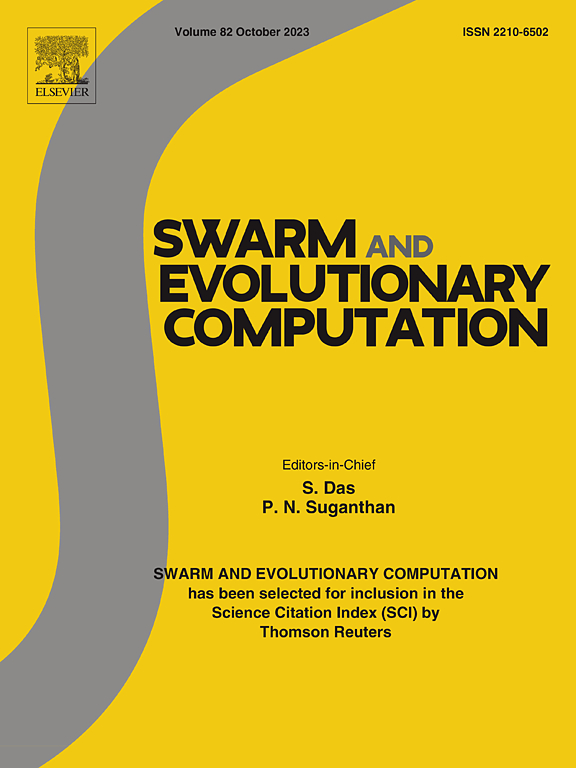基于黑翼风筝算法的优化多源特征提取模型逐时无缝估计PM2.5
IF 8.5
1区 计算机科学
Q1 COMPUTER SCIENCE, ARTIFICIAL INTELLIGENCE
引用次数: 0
摘要
细颗粒物(PM2.5)的估算对公众健康保护和空气质量管理具有重要意义。然而,单源数据集难以提取有效的数据特征,容易导致数据丢失。而多源数据PM2.5估算方法也会增加数据维数和非线性数据耦合。本文提出了一种新的逐小时无缝PM2.5估计方法,该方法通过基于可解释表学习网络(TabNet)的特征提取和分类提升(CatBoost)预测模型,利用多源数据集成。首先,构建卫星与再分析数据融合的多源数据集,解决缺失的时空数据问题,实现逐时无缝估计;其次,采用黑翼风筝算法(BKA)对TabNet结构参数进行优化,从多源数据中有效提取关键特征信息;然后利用CatBoost对逐时无缝PM2.5浓度进行贝叶斯优化(BO)估计,提高了整个模型的泛化性能。最后,利用京津冀(BTH)地区多源数据集进行实验分析和验证。结果表明,BKA在优化TabNet特征提取方面优于其他算法。该方法在逐时无缝PM2.5估计中表现优异,白天和夜间模型的R2分别达到0.91和0.92,RMSE分别低至12.22和11.70 μg/m3,优于其他回归模型。每小时PM2.5估算值与观测值基本一致,验证了其在不同空间位置的适用性。本文章由计算机程序翻译,如有差异,请以英文原文为准。
An optimized multi-source feature extraction model with black-winged kite algorithm for hourly seamless PM2.5 estimation
Fine particulate matter (PM2.5) estimation is becoming of significant importance for public health protection and air quality management. However, it is difficult to extract effective data features and easily lead to data missing with single-source dataset. And the multi-source data PM2.5 estimation method will also increase data dimensionality and nonlinear data coupling. In this paper, a novel hourly seamless PM2.5 estimation method is proposed with leveraging multi-source data integration through attentive interpretable tabular learning network (TabNet)-based feature extraction and the categorical boosting (CatBoost) prediction model. Firstly, a multi-source dataset is constructed for the satellite and reanalysis data fusion to solve the missing spatio-temporal data problem and to realize the hourly seamless estimation. Secondly, the TabNet structural parameters are optimized by the black-winged kite algorithm (BKA), effectively extracting key feature information from the multi-source data. And then the hourly seamless PM2.5 concentration is estimated by CatBoost with Bayesian optimization (BO), which improves the generalization performance of the whole model. Finally, the multi-source dataset of Beijing-Tianjin-Hebei (BTH) region is used for the experimental analysis and validation. The results demonstrate that BKA has superiority over other algorithms in optimizing TabNet feature extraction. The proposed method exhibits excellent performance in hourly seamless PM2.5 estimation, with the R2 of the day and night models reaching 0.91 and 0.92 and the RMSE as low as 12.22 μg/m3 and 11.70 μg/m3, which are better than other regression models. In addition, the hourly PM2.5 estimated are generally consistent with observations and the applicability across various spatial locations is validated.
求助全文
通过发布文献求助,成功后即可免费获取论文全文。
去求助
来源期刊

Swarm and Evolutionary Computation
COMPUTER SCIENCE, ARTIFICIAL INTELLIGENCEC-COMPUTER SCIENCE, THEORY & METHODS
CiteScore
16.00
自引率
12.00%
发文量
169
期刊介绍:
Swarm and Evolutionary Computation is a pioneering peer-reviewed journal focused on the latest research and advancements in nature-inspired intelligent computation using swarm and evolutionary algorithms. It covers theoretical, experimental, and practical aspects of these paradigms and their hybrids, promoting interdisciplinary research. The journal prioritizes the publication of high-quality, original articles that push the boundaries of evolutionary computation and swarm intelligence. Additionally, it welcomes survey papers on current topics and novel applications. Topics of interest include but are not limited to: Genetic Algorithms, and Genetic Programming, Evolution Strategies, and Evolutionary Programming, Differential Evolution, Artificial Immune Systems, Particle Swarms, Ant Colony, Bacterial Foraging, Artificial Bees, Fireflies Algorithm, Harmony Search, Artificial Life, Digital Organisms, Estimation of Distribution Algorithms, Stochastic Diffusion Search, Quantum Computing, Nano Computing, Membrane Computing, Human-centric Computing, Hybridization of Algorithms, Memetic Computing, Autonomic Computing, Self-organizing systems, Combinatorial, Discrete, Binary, Constrained, Multi-objective, Multi-modal, Dynamic, and Large-scale Optimization.
 求助内容:
求助内容: 应助结果提醒方式:
应助结果提醒方式:


